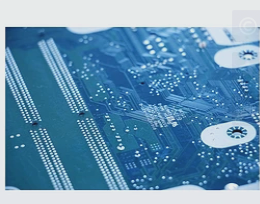The PCB consists of various components and incorporates a range of complex processing technologies. Its structure can be single-layer, double-layer, or multi-layer, with each type requiring distinct production methods.
First, the printed circuit board is primarily made up of pads, vias, mounting holes, traces, components, connectors, fills, and electrical boundaries. The main functions of each component are as follows:
Pad: A metal pad utilized for soldering the pins of components.
Via: A metal hole that facilitates the connection of component pins between different layers.
Mounting hole: Employed to secure the printed circuit board in place.

**Wire:** The copper film in the electrical network that connects the pins of various components.
**Connectors:** Components utilized to establish connections between circuit boards.
**Filling:** Copper coating applied to the ground wire network, effectively reducing impedance.
**Electrical boundary:** Defines the dimensions of the circuit board, ensuring that no components extend beyond this boundary.
Second, the typical layer structures of printed circuit boards are categorized into three types: single-layer PCB, double-layer PCB, and multi-layer PCB. A brief description of these structures is provided below:
(1) **Single-layer board:** A circuit board with copper on one side and no copper on the reverse. Components are typically mounted on the non-copper side, while the copper side is primarily used for wiring and soldering.
(2) **Double-layer board:** A circuit board featuring copper on both sides, commonly referred to as the top layer and bottom layer. The top layer is generally designated for component placement, while the bottom layer serves as the soldering surface for components.
(3) **Multilayer board:** A circuit board that encompasses multiple operational layers. In addition to the top and bottom layers, it consists of several intermediate layers. These intermediate layers can function as wiring layers, signal layers, power layers, or ground layers. Each layer is insulated from the others, with connections typically made through vias.
Third, printed circuit boards comprise various types of working layers, including signal layers, protective layers, silk screen layers, and internal layers. A brief overview of each layer’s functions is as follows:
(1) **Signal layer:** Primarily used for component placement or wiring. Protel DXP typically features 30 middle layers, designated as Mid Layer1 through Mid Layer30, which arrange signal lines, while the top and bottom layers accommodate components or copper deposition.
(2) **Protective layer:** Designed to ensure that areas of the circuit board that do not require tinning remain untinned, thereby maintaining the circuit board’s operational reliability. Top Paste and Bottom Paste refer to the top and bottom solder masks, respectively; Top Solder and Bottom Solder denote the solder paste protection layers for the top and bottom sides.
(3) **Silk screen layer:** Primarily utilized to print details such as serial numbers, production numbers, and company names on the printed circuit board.
(4) **Internal layer:** Mainly functions as a signal wiring layer. Protel DXP includes 16 internal layers.
(5) **Other layers:** This category encompasses four types of layers.
**Drill Guide (drilling azimuth layer):** Primarily used to indicate the locations of drilling holes on the printed circuit board.
First, the printed circuit board is primarily made up of pads, vias, mounting holes, traces, components, connectors, fills, and electrical boundaries. The main functions of each component are as follows:
Pad: A metal pad utilized for soldering the pins of components.
Via: A metal hole that facilitates the connection of component pins between different layers.
Mounting hole: Employed to secure the printed circuit board in place.

**Wire:** The copper film in the electrical network that connects the pins of various components.
**Connectors:** Components utilized to establish connections between circuit boards.
**Filling:** Copper coating applied to the ground wire network, effectively reducing impedance.
**Electrical boundary:** Defines the dimensions of the circuit board, ensuring that no components extend beyond this boundary.
Second, the typical layer structures of printed circuit boards are categorized into three types: single-layer PCB, double-layer PCB, and multi-layer PCB. A brief description of these structures is provided below:
(1) **Single-layer board:** A circuit board with copper on one side and no copper on the reverse. Components are typically mounted on the non-copper side, while the copper side is primarily used for wiring and soldering.
(2) **Double-layer board:** A circuit board featuring copper on both sides, commonly referred to as the top layer and bottom layer. The top layer is generally designated for component placement, while the bottom layer serves as the soldering surface for components.
(3) **Multilayer board:** A circuit board that encompasses multiple operational layers. In addition to the top and bottom layers, it consists of several intermediate layers. These intermediate layers can function as wiring layers, signal layers, power layers, or ground layers. Each layer is insulated from the others, with connections typically made through vias.
Third, printed circuit boards comprise various types of working layers, including signal layers, protective layers, silk screen layers, and internal layers. A brief overview of each layer’s functions is as follows:
(1) **Signal layer:** Primarily used for component placement or wiring. Protel DXP typically features 30 middle layers, designated as Mid Layer1 through Mid Layer30, which arrange signal lines, while the top and bottom layers accommodate components or copper deposition.
(2) **Protective layer:** Designed to ensure that areas of the circuit board that do not require tinning remain untinned, thereby maintaining the circuit board’s operational reliability. Top Paste and Bottom Paste refer to the top and bottom solder masks, respectively; Top Solder and Bottom Solder denote the solder paste protection layers for the top and bottom sides.
(3) **Silk screen layer:** Primarily utilized to print details such as serial numbers, production numbers, and company names on the printed circuit board.
(4) **Internal layer:** Mainly functions as a signal wiring layer. Protel DXP includes 16 internal layers.
(5) **Other layers:** This category encompasses four types of layers.
**Drill Guide (drilling azimuth layer):** Primarily used to indicate the locations of drilling holes on the printed circuit board.




